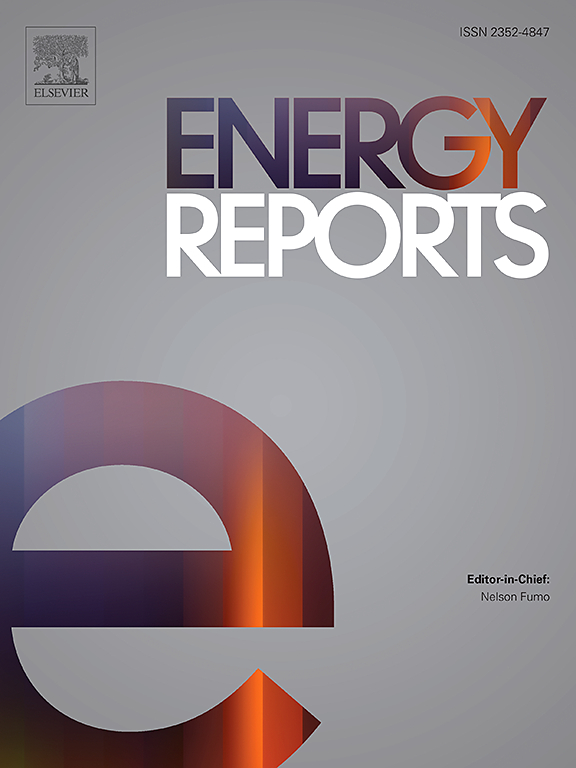Experimental assessment of ceiling cooling systems incorporating PCM in flat and domed roofs: Energy, environmental, and economic performance in hot-dry climates
IF 5.1
3区 工程技术
Q2 ENERGY & FUELS
引用次数: 0
Abstract
This study experimentally assesses the cooling performance of phase change material (PCM)-integrated ceiling systems in two roof configurations—flat and domed—under the hot-dry climate of Yazd, Iran. The objective is to evaluate the thermal, economic, and environmental benefits of PCM-based ceiling systems compared to conventional systems. A ¼-scale building model was used to examine three configurations: a basic PCM ceiling, a fan-assisted PCM ceiling (PCM-F), and a mini cooler-assisted PCM ceiling (PCM-C), in both flat and domed roof setups. Comparative analysis shows that PCM integration reduces average indoor air temperature by up to 4 °C in the flat roof and 5 °C in the domed roof. The PCM-C configuration achieves the most effective cooling and thermal comfort, particularly with the domed roof, due to improved air circulation. Relative humidity remained largely unchanged in the PCM and PCM-F scenarios but increased by 6–8 % in the PCM-C configuration. Economic analysis over a 30-year period indicates that PCM-F offers the lowest total cost, with the domed roof reducing operating costs by up to 10 % compared to the flat roof. Environmental impact analysis reveals that PCM systems lower CO₂ emissions by up to 53 %, with domed roofs performing slightly better than the flat one. The findings suggest that PCM-integrated domed ceiling system, especially when combined with auxiliary cooling, offers a promising strategy for passive cooling and energy savings in hot-dry climates.
在平面和圆顶屋顶中结合PCM的天花板冷却系统的实验评估:在干热气候下的能源、环境和经济性能
本研究实验评估了在伊朗亚兹德干热气候下,两种屋顶结构(平屋顶和圆屋顶)下相变材料(PCM)集成天花板系统的冷却性能。目的是评估与传统系统相比,基于pcm的天花板系统的热、经济和环境效益。1 / 4比例的建筑模型用于检查三种配置:基本的PCM天花板,风扇辅助的PCM天花板(PCM- f)和迷你冷却器辅助的PCM天花板(PCM- c),用于平屋顶和圆顶屋顶设置。对比分析表明,PCM集成可使平屋顶的平均室内空气温度降低4°C,使圆顶屋顶的平均室内空气温度降低5°C。PCM-C结构实现了最有效的冷却和热舒适,特别是由于改善了空气循环,圆顶屋顶。相对湿度在PCM和PCM- f方案中基本保持不变,但在PCM- c方案中增加了6 - 8% %。30年的经济分析表明,PCM-F提供了最低的总成本,与平屋顶相比,圆顶屋顶可将运营成本降低10% %。环境影响分析显示,PCM系统可将CO₂排放量降低高达53% %,而圆顶屋顶的性能略好于平屋顶。研究结果表明,pcm集成的圆顶天花板系统,特别是与辅助冷却相结合时,为干热气候的被动冷却和节能提供了一种有前途的策略。
本文章由计算机程序翻译,如有差异,请以英文原文为准。
求助全文
约1分钟内获得全文
求助全文
来源期刊

Energy Reports
Energy-General Energy
CiteScore
8.20
自引率
13.50%
发文量
2608
审稿时长
38 days
期刊介绍:
Energy Reports is a new online multidisciplinary open access journal which focuses on publishing new research in the area of Energy with a rapid review and publication time. Energy Reports will be open to direct submissions and also to submissions from other Elsevier Energy journals, whose Editors have determined that Energy Reports would be a better fit.
 求助内容:
求助内容: 应助结果提醒方式:
应助结果提醒方式:


